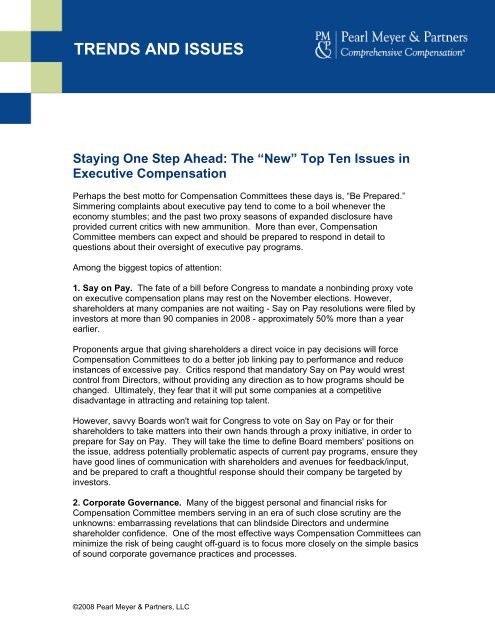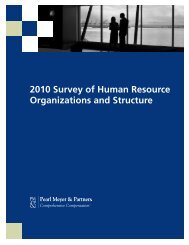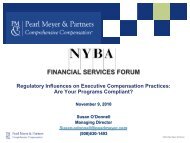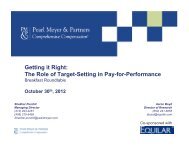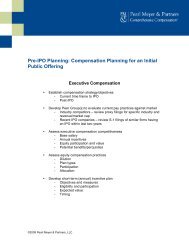Download - Pearl Meyer & Partners
Download - Pearl Meyer & Partners
Download - Pearl Meyer & Partners
You also want an ePaper? Increase the reach of your titles
YUMPU automatically turns print PDFs into web optimized ePapers that Google loves.
TRENDS AND ISSUES<br />
Staying One Step Ahead: The “New” Top Ten Issues in<br />
Executive Compensation<br />
Perhaps the best motto for Compensation Committees these days is, “Be Prepared.”<br />
Simmering complaints about executive pay tend to come to a boil whenever the<br />
economy stumbles; and the past two proxy seasons of expanded disclosure have<br />
provided current critics with new ammunition. More than ever, Compensation<br />
Committee members can expect and should be prepared to respond in detail to<br />
questions about their oversight of executive pay programs.<br />
Among the biggest topics of attention:<br />
1. Say on Pay. The fate of a bill before Congress to mandate a nonbinding proxy vote<br />
on executive compensation plans may rest on the November elections. However,<br />
shareholders at many companies are not waiting - Say on Pay resolutions were filed by<br />
investors at more than 90 companies in 2008 - approximately 50% more than a year<br />
earlier.<br />
Proponents argue that giving shareholders a direct voice in pay decisions will force<br />
Compensation Committees to do a better job linking pay to performance and reduce<br />
instances of excessive pay. Critics respond that mandatory Say on Pay would wrest<br />
control from Directors, without providing any direction as to how programs should be<br />
changed. Ultimately, they fear that it will put some companies at a competitive<br />
disadvantage in attracting and retaining top talent.<br />
However, savvy Boards won't wait for Congress to vote on Say on Pay or for their<br />
shareholders to take matters into their own hands through a proxy initiative, in order to<br />
prepare for Say on Pay. They will take the time to define Board members' positions on<br />
the issue, address potentially problematic aspects of current pay programs, ensure they<br />
have good lines of communication with shareholders and avenues for feedback/input,<br />
and be prepared to craft a thoughtful response should their company be targeted by<br />
investors.<br />
2. Corporate Governance. Many of the biggest personal and financial risks for<br />
Compensation Committee members serving in an era of such close scrutiny are the<br />
unknowns: embarrassing revelations that can blindside Directors and undermine<br />
shareholder confidence. One of the most effective ways Compensation Committees can<br />
minimize the risk of being caught off-guard is to focus more closely on the simple basics<br />
of sound corporate governance practices and processes.<br />
©2008 <strong>Pearl</strong> <strong>Meyer</strong> & <strong>Partners</strong>, LLC
As a start, Compensation Committee members should address the following questions:<br />
• Is there a Director-driven process for making decisions? Do members or<br />
management control the Committee's agenda? How does the Committee ensure it<br />
is getting all relevant information?<br />
• Do members truly understand how programs work, especially basic but key points<br />
such as how competitive data is used and the sensitivity of payouts to variations in<br />
stock price and corporate performance?<br />
• Does the Committee have an easily accessible institutional memory? Is there<br />
continuity from meeting to meeting such that new Committee members can be<br />
effective immediately?<br />
• Does the Committee regularly evaluate its own effectiveness and the effectiveness of<br />
each Committee member? Does the Committee evaluate the effectiveness of its<br />
compensation consultant and the governance process in general as it relates to<br />
executive compensation?<br />
3. Post-Separation Pay. Some of the most damaging headlines related to<br />
compensation in recent years have involved executives, often at financially troubled<br />
companies, receiving significant separation packages when they departed. The practice<br />
has become even more controversial in light of revised proxy rules, which require<br />
detailed disclosure of the value of such awards.<br />
Many companies are reconsidering whether cash-severance for executives is routinely<br />
necessary or even appropriate, especially if the executive has been with the firm for<br />
several years and has already accumulated significant wealth from the company.<br />
The tide may be turning, slowly. Over the past year, more companies have made or<br />
have considered making changes to long-established programs, in some cases by<br />
putting a cap on severance multiples based on the number of years the executive has<br />
held the position. Companies have also given more consideration to sunset provisions,<br />
in which the severance multiple declines as tenure increases.<br />
4. Change-in-Control Pay. A related and increasingly controversial element of<br />
executive pay programs is change-in-control arrangements. In an earlier attempt to curb<br />
perceived abuses, congress, in 1984, imposed a 20% excise tax on change-in-control<br />
payment that exceed three times the average value of an executive’s pay over the<br />
previous five years. In response, however, many companies began providing gross-ups<br />
that essentially reimbursed the executive for any excise tax owed and shifted the tax<br />
burden from the executive to the shareholders.<br />
Critics point out that the cost of a gross-up to the company can outweigh the benefits. In<br />
some cases, the value of a gross-up can approach millions of dollars, plus the company<br />
cannot take a tax deduction on the excess payment. Recently, some institutional<br />
shareholders and activist groups have taken the position that a gross-up is a poor and<br />
unnecessary compensation practice and are going so far as to recommend “against”<br />
votes for Committee members that implement such a practice.<br />
©2008 <strong>Pearl</strong> <strong>Meyer</strong> & <strong>Partners</strong>, LLC
Some shareholder groups are also taking the stance that "single trigger" provisions,<br />
which allow equity awards to vest immediately upon a change-in-control, are another<br />
example of egregious pay. As a result, "double trigger" provisions, in which the vesting<br />
of equity awards accelerate only if the executive is actually terminated following a<br />
change-in-control, are considered the best practice.<br />
5. Pay-for-Performance. Pay-for-performance can be difficult to define, but with the<br />
drive to improve Board and Committee processes, posing some basic questions can<br />
provide a helpful framework for dealing with this complex issue:<br />
• Are performance standards absolute, or evaluated relative to other companies?<br />
• How is "pay" defined - is it on an annual basis or cumulative?<br />
• How is performance defined - is it an increase in total shareholder return, return on<br />
investment capital, total revenue, or another metric or a combination of metrics?<br />
• Is performance assessed over the short- or long-term?<br />
• To what extent will changes in stock price or financial performance affect short- and<br />
long-term payouts?<br />
• Are performance metrics focused on the most important factors for the company and<br />
within the industry?<br />
6. Expanded SEC Disclosure Rules. Now in its second year, the SEC's heightened<br />
standards for reporting of executive compensation programs remain a work in progress.<br />
While this year's disclosures were better in some respects over the year before, there is<br />
still much room for improvement. For example, criticism by the SEC that many 2007<br />
disclosures were overly long and hard to understand produced little improvement in<br />
2008, according to a recent study by <strong>Pearl</strong> <strong>Meyer</strong> & <strong>Partners</strong> of 50 early filer companies.<br />
The study found that at the median, firms’ Compensation Discussion & Analysis sections<br />
were actually 13% longer than the previous year, while the median number of pages<br />
swelled by nearly one-third. Similarly, tests of readability suggested no progress toward<br />
meeting the SEC’s “plain English” standard.<br />
Further, the study suggested that while more companies opted to disclose performance<br />
goals this year, a significant number of firms opted not to disclose this information. Of<br />
the firms that did not disclose performance goals, few made the argument that<br />
disclosure would result in competitive harm to the company. It is anticipated that the<br />
disclosure of performance goals will remain an SEC focus, along with the disclosure of<br />
how compensation decisions are made and why.<br />
Of note, in a related <strong>Pearl</strong> <strong>Meyer</strong> & <strong>Partners</strong> study of companies’ views of the 2008<br />
proxy disclosure process (2008 “Proxies that Make the Grade” report), companies<br />
indicated that concerns about how programs will be perceived by investors have<br />
prompted design changes to short- and long-term incentive programs.<br />
Both the 2008 “Proxies that Make the Grade” and “Early 50 Filers” reports are available for download at<br />
www.pearlmeyer.com.<br />
©2008 <strong>Pearl</strong> <strong>Meyer</strong> & <strong>Partners</strong>, LLC
7. Benchmarking and Setting Pay. Compensation Committees recognize that it is no<br />
longer sufficient to tell shareholders a CEO deserves above-market pay just because he<br />
or she is talented and hard to replace. Good governance demands that compensation<br />
decisions are defensible and not made in a vacuum. However, under the intense<br />
scrutiny of shareholders, there can be a tendency for Committee members to rely too<br />
heavily on competitive market data. Committees should avoid “chasing the data” and<br />
feeling compelled to mark to market just because their company’s general philosophy is<br />
to target, for example, the 50 th percentile. The talent market is a place where the value<br />
to the beholder is determined by more than price alone. Rather than relying entirely on<br />
competitive data, Committee members can and should use good business judgment and<br />
take into account factors such as the executive’s experience, skills, and contributions,<br />
the company’s performance relative to its peers and whether the business model,<br />
organizational structure, and executive’s responsibilities are truly comparable to the<br />
peers/market. These perspectives can point to the need to adjust pay in either direction,<br />
upwards or downwards.<br />
8. Internal Equity. Expanded disclosure has put a spotlight on internal equity, giving<br />
shareholders more insight into the gaps that may exist between the CEO’s pay versus<br />
that of other named executive officers. Further, more detailed proxies have opened<br />
executives’ eyes to what their superiors and peers in other companies are paid. Boards<br />
that ignore major and unexplained differences in pay risk losing top talent, causing rifts<br />
among executives, and receiving negative shareholder attention.<br />
9. Consultant Independence. There are two main aspects of the consultant<br />
independence issue: one is the reporting relationship of consultants with Committee<br />
members and management; and the other is the types of services provided to the<br />
company. The consultant independence issue was a major focus in the recent Waxman<br />
Congressional hearings on executive compensation. Corporate governance experts,<br />
institutional investors, CEOs of large companies, and compensation consulting firms<br />
testified in front of a House subcommittee regarding the role of consultants in setting<br />
executive pay and efforts to prevent and manage real and perceived conflicts of interest.<br />
Company Boards have taken notice and have begun to stress this issue in order to avoid<br />
the potential of a “front-page” effect. In a study of recent proxy filings, some interesting<br />
statistics were found regarding how companies are disclosing the relationship they have<br />
with compensation consultants:<br />
• In both 2007 and 2008, 90% of companies said their compensation consultant<br />
was retained by the Compensation Committee, rather than by management.<br />
• 12% of companies in 2008 specified that their compensation consultants were<br />
independent, provided only compensation-related services to the company and<br />
had no conflicts of interest - up slightly from 7% in 2007.<br />
• About 81% of the firms provided a description of their compensation consultants’<br />
services, up from 73% in 2007.<br />
©2008 <strong>Pearl</strong> <strong>Meyer</strong> & <strong>Partners</strong>, LLC
10. The "How Much is Too Much?" Issue. No one has come up with an absolute point<br />
at which an executive is universally said to be overpaid. Generally, investors have not<br />
objected to executives being handsomely rewarded, provided they spread the wealth in<br />
the form of increased shareholder value. The most notorious pay scandals have<br />
typically involved unusually high compensation provided when shareholders saw<br />
relatively little benefit, either because the results achieved weren't significant or<br />
impressive results were later discredited. Generally speaking, Compensation<br />
Committees have a good sense of whether pay packages being provided are<br />
disproportionate, or truly in line with the value the executives have provided to the<br />
company and its shareholders.<br />
While examples of egregious pay still do exist, two relatively easy ways Committees can<br />
minimize the frequency of these instances is by implementing and following sound<br />
corporate governance practices and regularly examining the competitiveness of<br />
executive pay programs and practices. In combination with competitive assessments,<br />
other ways Committees can reduce the risk of excessive pay is by examining executives’<br />
wealth accumulation and conducting “forward looking” analyses - such as an economic<br />
impact analysis - where potential payouts for executives are modeled out based on<br />
projected or assumed corporate performance and stock price appreciation.<br />
©2008 <strong>Pearl</strong> <strong>Meyer</strong> & <strong>Partners</strong>, LLC
NEW YORK<br />
445 Park Avenue<br />
New York, NY 10022<br />
(212) 644-2300<br />
newyork@pearlmeyer.com<br />
ATLANTA<br />
One Alliance Center<br />
3500 Lenox Road, Suite 1708<br />
Atlanta, GA 30326<br />
(770) 261-4080<br />
atlanta@pearlmeyer.com<br />
BOSTON<br />
132 Turnpike Road, Suite 300<br />
Southborough, MA 01772<br />
(508) 460-9600<br />
boston@pearlmeyer.com<br />
CHARLOTTE<br />
3326 Siskey Parkway, Suite 330<br />
Matthews, NC 28105<br />
(704) 844-6626<br />
charlotte@pearlmeyer.com<br />
www.pearlmeyer.com<br />
CHICAGO<br />
123 N. Wacker Drive, Suite 1225<br />
Chicago, IL 60606<br />
(312) 242-3050<br />
chicago@pearlmeyer.com<br />
HOUSTON<br />
Three Riverway, Suite 1575<br />
Houston, TX 77056<br />
(713) 568-2200<br />
houston@pearlmeyer.com<br />
LOS ANGELES<br />
550 S. Hope Street, Suite 1600<br />
Los Angeles, CA 90071<br />
(213) 438-6500<br />
losangeles@pearlmeyer.com<br />
©2008 <strong>Pearl</strong> <strong>Meyer</strong> & <strong>Partners</strong>, LLC


